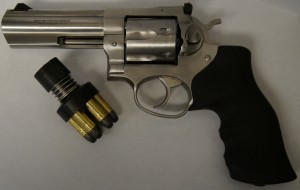In order to start getting ready for IDPA Nationals, I actually had to take the Ruger out to the practice range and shoot it, which was something I hadn’t done for a bit. According to my logbook, the last practice session I had logged was in on May 29th. That seemed like an excessive amount of downtime, and it was time to put that to an end.
That meant a trip to the best indoor range west of the Rockies, West Coast Armory in Bellevue, WA. I wanted to focus my practice session on the most important skill in revolver shooting: the reload. Additionally, I wanted to make sure the gun was sighted in and gather some data ln how different this would be from the S&W revolvers I’ve used in the past. The GP100 delivered a big surprise to me right off the bat, when I realized that the sights were regulated for 130 grain rounds. Every other .357 Magnum revolver I’ve ever owned had the factory sights set for 158 grain bullets, which made the Ruger’s sights a bit of a surprise. Of course, like an idiot I forgot to bring the proper screwdriver to adjust the sights, which wasn’t a big deal. The Ruger was plenty accurate – standing unsupported it fired a 3 inch group at 25 yards using 158 grain LRN.
To the actual shooting, my big focus was on one critical area: reloads. When I was shooting a lot of revolver, I was able to hit reloads with a speedloader consistently in the 2.5 second range, with a really screaming reload being somewhere around 2.0/2.2 measured shot to shot. The problem with a speedloader reloader is that there is a lot more that can go wrong than with a moonclip reload. In no particular order, you could do any of the following:
- Not get the cartridges aligned right
- A round could hang up in the speedloader or the cylinder
- The speedloader might not drop away clear
And those are just the three things that were plaguing me last night. Of course, there are some mechanical remedies for some of that. I plan on having the charge holes chamfered, which for you non-revolver guys is sort of like putting a little tiny magwell on each charge hole to help the rounds find their way home. It’s not a big change, but it helps a lot. Getting rid of the factory grips will help as well, since they can interfere with the speedloader.
The actual practice went fairly well. My reloads started off in the 3.5 range, which felt really rough. As I worked, and worked, and worked some more, I was able to hit a couple of 2.75s and one 2.65, which felt really good. The trick is getting everything to line up consistently, which isn’t always easy. But, I actually enjoy practicing revolver reloads, so working out the mechanics of nailing the perfect speedloader reload is going to be fun.

Buy Best Guns we make our complete priority to satisfy our customers.
ReplyDeletewith the best firearms and quality of service to match with it.
buy RUGER GP100 .357 Mag
Call US:(435)227-5162
Email Id:support@buybestguns.com